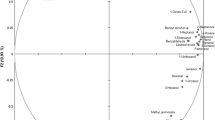Abstract
Fourteen volatile compounds occurring in leaf trichomes of yellow squash (Cucurbita pepo L. cv. Early Prolific Straightneck) were identified. These compounds accounted for 83.5% of the volatile matrix. Ubiquitous constituents of the epidermis (myristic, palmitic, and stearic acids,n-tricosane, andn-pentacosane) accounted for 73.7%; these compounds were not bioassayed. The volatileso-,m-, andp-xylene, toluene, 2-heptanone, (R)-(+)- and (S)-(−)-limonene, and germacrene D were tested for their influence on attraction and oviposition by the pickleworm moth (Diaphania nitidalis Stoll.). No single compound, except germacrene D, was attractive. (R)-(+)-Limonene and 2-heptanone were weakly repellent. Mixtures of the highly volatile fractions were as attractive as volatiles emanating from whole, intact leaves. Oviposition levels on treated artificial sites corresponded with levels of visitation. Oviposition was significantly stimulated by “whole-leaf” volatiles, and (S)-(−)-limonene caused a slight but significant reduction.
Similar content being viewed by others
References
Corley, W.L. 1973. Response of muskmelon botanical varieties to pickleworm infestation.HortScience 13:286–287.
Day, A., Nugent, P.E., andRobinson, J.F. 1978. Resistance of squash varieties to the pickleworm and the value of resistance to insecticide control.J. Econ. Entomol. 54:1191–1197.
Dell, B., andMcComb, J.A. 1978. Plant resins—their formation, secretion, and possible functions.Adv. Bot. Res. 6:276–316.
Elsey, K.D., andMcFadden, T.L. 1981. Pickleworm: Oviposition on an artificial surface treated with cucurbit extract.J. Econ. Entomol. 74:473–474.
Elsey, K.D., andWann, E.V. 1982. Differences in infestation of pubescent and glabrous forms of cucumber by pickleworms and melonworms.HortScience 17:253–254.
Elsey, K.D., McPadden, T.L., andCuthbert, F.P. 1984. Improved rearing systems for pickleworm and melonworm (Lepidoptera: Pyralidae).J. Econ. Entomol. 77:1070–1072.
Esau, K. 1965. Plant Anatomy. John Wiley & Sons, New York, 767 pp.
Horvat, R.J., Chapman, G.W., Jr., Robertson, J.A., Meredith, F.I., Scorza, R., Callahan, A.M., andMorgan, P. 1990. Comparison of the volatile compounds from several commercial peach cultivars.J. Agric. Food Chem. 38:234–237.
Levin, D.A. 1973. The role of trichomes in plant defense.Q. Rev. Biol. 48:3–15.
Peterson, J.K., andElsey, K.D. 1994. Chemical factors involved in oviposition host plant selection by the pickleworm moth (Diaphania nitidalis) (Lepidoptera: Pyralidae).Fla. Entomol. In press.
Pulliam, T.L. 1979. The effect of plant types and morphology of the cucumber,Cucumis sativus L. on infestation by the pickleworm,Diaphania nitidalis (Stoll.) MS thesis. North Carolina State University.
Quisumbing, A.R., andLower, R.L. 1975. Screening cucumber cultivars for pickleworm resistance.HortScience 10:147 (abstract).
Stein, S.E. 1990. United States Department of Commerce, National Institute of Standards and Technology. Standard Reference Data Program, Gaithersburg, Maryland.
Theobold, W.L., Krahulik, J.L., andRollins, R.C. 1979. Trichome description and classification,in C.R. Metcalfe and L. Chalk (eds.). Anatomy of the Dicotyledons, 2nd ed., Vol. I. Systematic Anatomy of Leaf and Stem, with a Brief History of the Subject.
Uphof, J.C. 1962. Plant hairs, pp. 1–206,in W. Zimmerman and P.G. Ozend (eds.). Encyclopedia of Plant Anatomy, Vol. 4, Part 5. Gebrüder Borntrager, Berlin.
Author information
Authors and Affiliations
Additional information
Mention of a trade name or proprietary product does not constitute a warranty or guarantee by the U.S. Department of Agriculture, nor does it imply exclusion of other products that may also be suitable.
Rights and permissions
About this article
Cite this article
Peterson, J.K., Horvat, R.J. & Elsey, K.D. Squash leaf glandular trichome volatiles: Identification and influence on behavior of female pickleworm moth [Diaphania nitidalis (Stoll.)] (Lepidoptera: Pyralidae). J Chem Ecol 20, 2099–2109 (1994). https://doi.org/10.1007/BF02066246
Received:
Accepted:
Issue Date:
DOI: https://doi.org/10.1007/BF02066246




